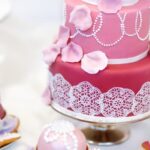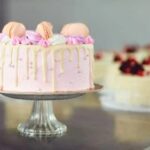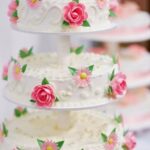The art of cake decoration holds a special place in the culinary world, captivating both professionals and amateurs alike. From elegant wedding cakes to whimsical birthday creations, the skill of cake decorating has become an essential part of celebratory events. In this article, we will explore the magical world of cake decoration and provide you with guidance on how to embark on your journey to becoming a cake decorator.
Cake decoration is not just about adding a touch of beauty to a dessert; it is an expressive form of art that transforms a simple cake into a work of edible art. With its ability to captivate and delight, cake decoration has gained immense popularity over the years. Whether it’s birthdays, weddings, anniversaries, or holidays, no celebration seems complete without a beautifully decorated cake as its centerpiece.
Learning the art of cake decoration requires more than simply mastering a few techniques; it demands passion and dedication. Those who pursue this skill are driven by their love for creating visually stunning treats that bring joy to others. It is this inner drive that fuels their creativity and pushes them to continuously improve their skills as they experiment with new techniques and ideas.
In the next sections, we will delve deeper into the world of cake decoration and guide you through essential skills and techniques needed for success. We will also discuss the necessary tools and resources that every aspiring decorator should have at their disposal. So if you’re ready to unleash your creative side and embark on an exciting journey of cakes and frosting, let’s dive into the wonderful world of cake decoration.
Setting the Foundation
Cake decorating is an art that requires not only skill but also a genuine passion for creating beautiful and delicious confections. To embark on a journey to become a cake decorator, it is crucial to develop a deep-rooted interest in this craft. This section will explore the personal interest and dedication required, as well as the motivations that drive individuals to pursue cake decorating.
The Importance of Personal Interest
Before diving into the world of cake decoration, it is essential to have a sincere love for baking and creativity. Cake decorators spend hours perfecting their craft, experimenting with new designs, and ensuring every detail contributes to an exquisite masterpiece. Without genuine personal interest, this level of dedication may be challenging to sustain.
Passion fuels creativity and ignites the desire to constantly improve one’s skills. Curiosity and excitement will lead aspiring cake decorators to push boundaries, explore new techniques, and experiment with unique flavor combinations. Those who truly enjoy every aspect of cake decoration will find joy in the process itself, irrespective of accolades or monetary gain.
Discovering Inspiration and Motivation
Many aspiring cake decorators draw their inspiration from various sources. For some, it may be the magic of watching their grandmother create stunning cakes during childhood celebrations. Others may find motivation through social media platforms where they stumble upon jaw-dropping cake designs by professional decorators.
Finding mentors within the baking community can also provide valuable guidance and inspiration. Attending workshops or classes led by experienced cake decorators allows beginners an opportunity to learn from experts while connecting with like-minded individuals who share their passion.
Ultimately, developing a passion for cake decorating involves exploring different techniques/styles and finding what resonates personally. It is through this self-discovery process that individuals gain motivation and begin building their unique path as a proficient decorator.
By fostering personal interest in baking, seeking inspiration from diverse sources, and constantly nourishing their motivation, aspiring cake decorators can set a firm foundation for their journey to become skilled artisans in the realm of cake decoration.
Essential Skills for Cake Decoration
When it comes to cake decoration, there are a few essential skills that every aspiring cake decorator needs to master. These skills form the foundation of creating beautiful and visually appealing cakes that are sure to impress. From the art of baking to mastering frosting and piping techniques, here are some key skills you should focus on developing.
Baking
Before you can start decorating cakes, you need a solid foundation in baking. Understanding the science behind baking and learning techniques for creating moist, fluffy cakes is crucial. This includes knowing how to measure ingredients accurately, understanding oven temperatures and baking times, and mastering different mixing methods.
Frosting
The next skill to focus on is frosting. As one of the main elements in cake decoration, frosting acts as a canvas for your creativity. You should learn various techniques for applying frosting smoothly and evenly on a cake, such as using an offset spatula or bench scraper for achieving a polished finish.
Piping Techniques
Piping is an important skill that allows you to create intricate designs and patterns on a cake. Practice different piping techniques like rosettes, dots, stars, and writing with various nozzles or tips. The key is to achieve consistent pressure when piping so that your designs are consistent throughout the cake.
Tips for Precision and Creativity
To improve precision in your cake decoration, it’s important to invest time in practicing your skills regularly. Pay attention to details like straight lines, clean edges, and symmetrical designs. Additionally, don’t be afraid to get creative with your decorations by experimenting with colors, textures, and shapes. A great way to enhance creativity is by drawing inspiration from nature, fashion trends, or even other forms of art.
| Skill | Description |
|---|---|
| Baking | Understanding the science of baking, accurate measurements, and different mixing methods |
| Frosting | Techniques for applying frosting smoothly and creating a polished finish |
| Piping Techniques | Mastering various piping techniques for creating intricate designs and patterns on cakes |
| Tips for Precision and Creativity | Improving precision by paying attention to details and getting creative with decorations |
Tools and Equipment
When it comes to cake decoration, having the right tools and equipment is essential. These tools not only make the process more efficient but also allow decorators to achieve professional-looking results. Whether you are a beginner or a seasoned cake decorator, here is a list of must-have tools and equipment that will help you elevate your skills:
Piping Bags
- Piping bags are a staple in cake decoration as they allow decorators to create intricate designs and patterns using frosting or icing. There are both disposable and reusable piping bags available in the market, so choose one that suits your preferences.
Spatulas
- Spatulas are versatile tools that come in various shapes and sizes. For smooth frosting application, an offset spatula is recommended, while an angled spatula is ideal for creating decorative textures on cakes.
Decorating Tips
- Having a variety of decorating tips is crucial for different techniques such as creating borders, writing messages, or making flowers. Wilton is a popular brand known for its wide range of decorating tips, offering options for every design imaginable.
Turntable
- A turntable is an absolute game-changer in cake decoration. It allows decorators to smoothly rotate their cakes while working on them, ensuring even coverage of frosting and ease in piping intricate designs. Invest in a sturdy turntable that can withstand the weight of your cakes.
Cake Leveler
- A cake leveler is used to slice off any domed tops from baked cakes, ensuring flat and even layers for stacking. This tool helps maintain stability while decorating multi-tiered cakes.
Fondant Tools
- If you plan to work with fondant, there are specific tools that can make the process much easier. These include a fondant smoother for achieving a flawless finish and gum paste tools for creating delicate sugar flowers and figurines.
When starting out, it can be overwhelming to choose from the wide array of cake decorating tools available in the market. To avoid wasting money on unnecessary items, consider investing in quality products from trusted brands that will last you a long time. Remember that practice and skill development are just as crucial as having the right tools, so keep honing your cake decoration skills while expanding your toolkit.
Mastering the Basics
Cake decorating is an art form that requires practice and skill. Mastering the basics of cake decorating is essential for anyone looking to create beautiful and professional-looking cakes. In this section, we will delve into the step-by-step techniques that will help you become a proficient cake decorator.
Leveling and filling cakes:
Before you begin decorating your cake, it is crucial to ensure that it has an even surface. Leveling your cake involves trimming off any domed or uneven tops using a serrated knife or a leveler tool. Once the cake is leveled, you can proceed to fill it with your choice of filling, such as buttercream, ganache, or fruit preserves. Use an offset spatula to spread the filling evenly between each layer of cake.
Crumb coating:
To achieve a smooth final appearance for your decorated cake, crumb coating is an essential technique. Crumb coating involves applying a thin layer of frosting on the exterior of the cake to trap any loose crumbs before adding the final layer of frosting.
Start by applying a generous amount of frosting on top of the crumb-coated cake, then use an offset spatula to spread it around and ensure even coverage. Smooth out any imperfections with a bench scraper or a large straight-edge spatula.
Fondant application:
Fondant is a versatile icing made from sugar, water, and other flavorings that can be rolled out and draped over cakes for a sleek finish. Before applying fondant, make sure your crumb-coated cake is chilled in the refrigerator for about 30 minutes to prevent it from being too soft and sticky.
Roll out your fondant using a rolling pin on a lightly dusted surface with cornstarch or powdered sugar to prevent sticking. Carefully lift the fondant over your cake and gently press it down using your hands or a fondant smoother to remove any air bubbles or wrinkles.
By mastering these basic cake decorating techniques, you will be well on your way to creating beautifully decorated cakes. Practice is key, so don’t be afraid to experiment and learn from your mistakes. Remember, even professional cake decorators started as beginners, so embrace the learning process and enjoy the art of cake decoration.
Exploring Advanced Techniques
When it comes to cake decorating, the possibilities are endless. Once you have mastered the basics of cake decoration, it’s time to take your skills to the next level by exploring advanced techniques that will truly elevate your creations. In this section, we will delve into some of these techniques and provide resources and recommendations for further learning and improvement.
One advanced technique that can make a big impact on your cake designs is the art of creating sugar flowers. Sugar flowers add an elegant and realistic touch to any cake, whether it’s a wedding masterpiece or a birthday celebration.
Learning how to craft these intricate blooms requires patience and practice, but the results are truly breathtaking. There are plenty of online tutorials, books, and even workshops available for those interested in delving deeper into the world of sugar flower making.
Another way to elevate your cake decorating skills is by mastering intricate patterns. From delicate lace designs to geometric patterns, there are countless ways to create visually stunning cakes using different piping techniques. Experiment with different piping tips and practice piping techniques like filigree or brush embroidery. Online video tutorials can be a great resource for learning these advanced piping techniques.
If you’re feeling particularly adventurous, try your hand at sculpted cake designs. Sculpted cakes involve shaping the cake into various objects or characters, turning your sweet treats into edible works of art. Whether you’re creating a three-dimensional animal-shaped cake or a whimsical scene from a favorite movie, sculpted cakes require advanced carving skills and an eye for detail. There are specialized classes and workshops available that can guide you through the process of sculpted cake design.
| Advanced Technique | Resource/Recommendation |
|---|---|
| Sugar Flowers | Online tutorials, books, workshops |
| Intricate Piping Patterns | Online video tutorials |
| Sculpted Cake Designs | Specialized classes, workshops |
Finding Your Unique Style
Developing your own unique style in cake decoration is a crucial aspect of becoming a successful cake decorator. While it is important to learn and master fundamental techniques, finding your own signature style will set you apart from others in the field and help you create memorable cakes that reflect your individuality. Here are some tips to help you develop your signature cake decoration style:
- Experiment with different styles and themes: Take inspiration from various sources such as nature, art, fashion, or cultural elements, and explore different themes while decorating your cakes. Try incorporating different color palettes, textures, patterns, and designs to see what resonates with you.
- Embrace creativity and innovation: Don’t be afraid to think outside the box and push the boundaries of traditional cake decoration. Experiment with unconventional materials or techniques to create unique effects on your cakes.
- Pay attention to details: Attention to detail can make a significant difference in your cake decoration style. Focus on precision and strive for perfection in every element of your design – from piping techniques to fondant work.
- Find inspiration from other decorators: Study the work of other skilled cake decorators for inspiration but avoid copying them directly. Instead, identify what you appreciate about their work and use it as a starting point to develop your own spin on their ideas.
- Understand your target audience: Consider who your target audience is and what they value in a cake design. Understanding their preferences will help you tailor your style accordingly while still staying true to yourself.
Remember that developing a signature cake decoration style takes time and practice. Allow yourself room for growth and experimentation as you refine your skills along the way.
To further enhance your skillset and stay updated with industry trends, consider attending workshops or classes offered by experienced professionals. Additionally, participating in online forums or joining a community of like-minded individuals can provide valuable feedback and support during your journey towards developing a signature cake decoration style.
By embracing creative expression and continuously honing your skills, you will eventually develop a unique style that is truly yours. This individuality will not only set you apart from other cake decorators but also allow you to create cakes that are truly works of art.
Building a Successful Cake Decorating Business
In today’s world, turning your passion for cake decoration into a profitable business venture is not only possible but also highly rewarding. Many individuals have transformed their love for creating visually stunning cakes into successful enterprises, whether it be through establishing a home-based bakery or launching a professional cake decorating business. This section will provide insights and tips on how to build a thriving cake decorating business.
One of the first steps in setting up a cake decorating business is defining your target audience and identifying your niche. Determine whether you want to specialize in wedding cakes, themed cakes, or custom designs. Understanding the demand and preferences of your potential customers will help you tailor your services and marketing strategies accordingly. Conduct market research to gather information about competitors, pricing trends, and popular cake styles in your area.
Another crucial aspect of building a successful cake decorating business is creating a strong brand identity. Develop an attractive logo, create eye-catching packaging, and design a professional website to showcase your work. Utilize social media platforms like Instagram and Facebook to share photos of your cakes, engage with followers, and promote your services. Networking with local event planners, wedding venues, and catering companies can also help generate referrals and partnerships.
Managing finances efficiently is essential for any business endeavor. Keep track of expenses such as ingredients, tools, equipment maintenance, and marketing costs. Determine the appropriate pricing structure by considering factors such as ingredient costs, labor time invested in each cake design, and desired profit margins. Additionally, maintain accurate records of orders received and completed to ensure timely deliveries.
Lastly, customer satisfaction is paramount in building a thriving cake decorating business. Strive for high-quality products that not only look appealing but taste delicious as well. Offer sample tastings or consultations to potential clients so they can experience the quality of your cakes firsthand. Provide excellent customer service by promptly responding to inquiries and accommodating special requests whenever possible.
Starting a cake decorating business requires passion, creativity, and dedication. With the right skills, tools, and business strategies in place, you can turn your cake decoration hobby into a successful and fulfilling profession. Embrace this opportunity to share your artistic talent and bring joy to people’s celebrations through beautifully crafted cakes.
Conclusion
In conclusion, cake decoration is an art form that brings joy and beauty to various occasions and events. Throughout this article, we have explored the importance of developing a passion for cake decorating and the essential skills required to excel in this field. We have also delved into the necessary tools and equipment needed, as well as step-by-step techniques for both beginners and advanced decorators.
It is crucial to remember that cake decoration is a continuous learning process, just like any other art form. Aspiring decorators should embrace their passion for cake decoration and strive to continuously improve their skills. By experimenting with different styles, themes, and techniques, individuals can develop their own unique signature cake decoration style.
For those who wish to turn their love for cake decoration into a successful business venture, this article has offered valuable insights on building a profitable bakery or starting a professional cake decorating business. Marketing strategies and tips on attracting clients have also been shared.
Overall, the world of cake decoration offers endless possibilities for creativity and self-expression. Whether you are a hobbyist or aspiring professional, embracing your passion for cake decoration will allow you to create beautiful works of art while bringing joy to those who indulge in your creations. So go ahead and unleash your creativity – the sky’s the limit in the world of cake decoration.
Frequently Asked Questions
How do I start being a cake decorator?
Starting a career as a cake decorator begins with acquiring the necessary skills and knowledge in baking and cake decoration. One option is to enroll in a culinary school or institute that offers specialized courses in pastry arts or cake decorating. These programs typically provide hands-on training, teaching aspiring decorators the fundamental techniques such as frosting, piping, and designing cakes.
Alternatively, individuals can opt for self-study by using online resources, instructional videos, and books dedicated to cake decoration. Practice is crucial in honing your skills, so it is recommended to start creating cakes for family and friends or even volunteering to make cakes for events to gain experience.
How much money can you make cake decorating?
The income potential for a cake decorator can vary depending on several factors such as location, level of experience, reputation, type of clientele, and business model. As an entry-level decorator working for someone else’s bakery or cake shop, the salary may be modest initially but can increase over time with experience and skill development. On the other hand, experienced decorators who establish their own businesses or work freelance have greater control over their earnings potential.
By building a strong client base and developing unique designs and skills that set them apart from competitors, successful decorators can earn substantially more. However, it is essential to note that while there is potential for profitability in this field, it requires hard work, exceptional craftsmanship, effective marketing strategies, and excellent customer service to maximize earnings.
How long does it take to become a good cake decorator?
Becoming proficient in cake decorating is a continuous learning process that takes time and practice. While there is no set duration for becoming a “good” cake decorator as everyone learns at their own pace; generally speaking, it may take several years before one can confidently consider themselves skilled in this craft. Developing artistic flair and precision in creating intricate designs often requires consistent practice on various projects under different circumstances.
Additionally, staying updated with current trends and techniques within the industry through workshops or continuing education ensures growth as a decorator. It’s important to remember that improvement is a lifelong journey, and even experienced decorators continually seek inspiration and refine their skills to remain at the top of their game.

Welcome to my blog about home and family. This blog is a place where I will share my thoughts, ideas, and experiences related to these important topics. I am a stay-at-home mom with two young children. I hope you enjoy reading it! and may find some helpful tips and ideas that will make your home and family life even better!





